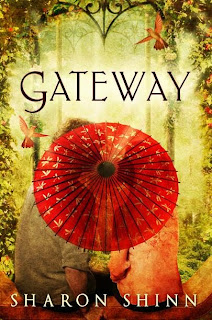Here are the reviews that I found:
13 Treasures, by Michelle Harrison, at Eva's Book Addiction
100 Cupboards, by N.D. Wilson, at Read in a Single Sitting.
The Adventures of Nanny Piggins, by R. A. Spratt, at Jean Little Library.
The Amaranth Enchantment, by Julie Berry, at The Book Nest.
Artemis Fowl and the Atlantis Complex, by Eoin Colfer, at The Book Zone (for boys).
Crossing Over (Suddenly Supernatural), by Elizabeth Cody Kimmel, at Books & Other Thoughts.
Dark Life, by Kat Falls, at The Book Zone (for Boys) and at Becky's Book Reviews.
Dragon Rider, by Cornelia Funke, at The Bookworm Chronicles.
The Ghost of Crutchfield Hall, by Mary Downing Hahn, at The Fourth Musketeer.
Ivy's Ever After, by Dawn Lairamore, at Eva's Book Addiction
Karma Bites, by Stacy Kramer and Valerie Thomas, at The O.W.L.
The Kneebone Boy, by Ellen Potter, at Book Aunt (note--Kate actually says this isn't fantasy, but since a lot of us (ie me) might have been making that assumption, I'm sticking it in anyway!)
No Such Thing as Dragons, by Philip Reeve, at Bookends.
Percy Jackson and the Battle of the Labyrinth, by Rick Riordan, at Nayu's Reading Corner.
The Princess Academy, by Shannon Hale, at Emily's Reading Room.
The Red Pyramid, by Rick Riordan, at Eva's Book Addiction.
Rise of the Darklings, by Paul Crilley, at Fantasy Literature.
The Shadows (Books of Elsewhere 1), by Jacqueline West, at Books Together.
A Tale Dark and Grimm, by Adam Gidwitz, at Fuse #8
The Unsinkable Walker Bean, a graphic novel by Aaron Renier, at 100 Scope Notes.
Where the Mountain Meets the Moon, by Grace Lin, at Book Reviews for LS 5653 Multicultural Literature for Children and Young Adults.
Whistle Bright Magic--a Nutfolk Tale, by Barb Bentler Ullman, at One Librarian's Book Reviews
The Witchy Worries of Abbie Adams, by Rhonda Hayter, at Charlotte's Library.
Interviews:
For over a year, a book called A Most Improper Magick has been on my to-be-read list. At last, today, it is published (in the UK)! Here's an interview with its author, Stephanie Burgis, at Bart's Bookshelf.
J. and P. Voekel (Middleworld) continue their blog tour at Reading in Color.
Other Fun Stuff:
Diana Wynne Jones Week kicks off at Jenny's Books! Since, very very sadly, Diana Wynne Jones is critically ill, taking part in the celebration of her great books is a wonderful chance to pay homage to one of the greatest writers of fantasy for the younger reader...(and older reader too). And, for affecianados of fairy tales, Once Upon a Week is also beginning today at Today's Adventure.
At Tamora Pierce's blog -- "Why I write girl heros for the most part."
The League of Extraordinary Writers has been busily discussing Among the Hidden, by Margaret Petterson Haddix, as their July Book Club selection.
I've gathered together two lists of Cold Fantasy Books for a hot summer's day--here are Part 1 (for younger readers, 7-10ish) and Part 2 (for older readers).
Over at The Spectacle, there's an interesting post on Violence in mg sff.
With her review of Merry Go Round In Oz, Mari Ness has now reviewed all 40 of the canonical Oz books. When I was nine or so, and found out that the Library of Congress existed, I made plans to spend several days there reading them all. After reading these reviews, I'm not so sure this is going to happen...
Just for kicks, I put up a poll to see which Newbery Award winner that was a fantasy/sci fi book is best beloved. 60 people have voted so far...
Not specifically fantasy related, but still of interest: the Kidlit Con 2010 (this October, Minneapolis) information is up, registration begins now (and is surprisingly affordable), and I have a swell room-mate lined up already! It's a great conference to go to--there is lots of time for just talking to other book minded folk.
And speaking of meeting, here's a picture of me (brown hair, green shirt) listening to the fantasy writing panel at the Toadstool that I went to a week ago (lifted from Angie Frazier's blog, where you can see more pictures:
 The authors shown, from r to l, are Deva Fagan, Angie Frazier, and 2/3 of Kate Milford. (Here's my account).
The authors shown, from r to l, are Deva Fagan, Angie Frazier, and 2/3 of Kate Milford. (Here's my account).If you enjoy these round-ups, please feel free to spread the word! And if I missed your post, or that of your best friend, etc., please let me know! (I am especially anxious that because I don't read that many author blogs, I am missing many Good Posts....so, if anyone reading this happens to either be an author of mg fantasy/sci fi, or an avid reader of such blogs, please feel free to contact me with links at any time!).























